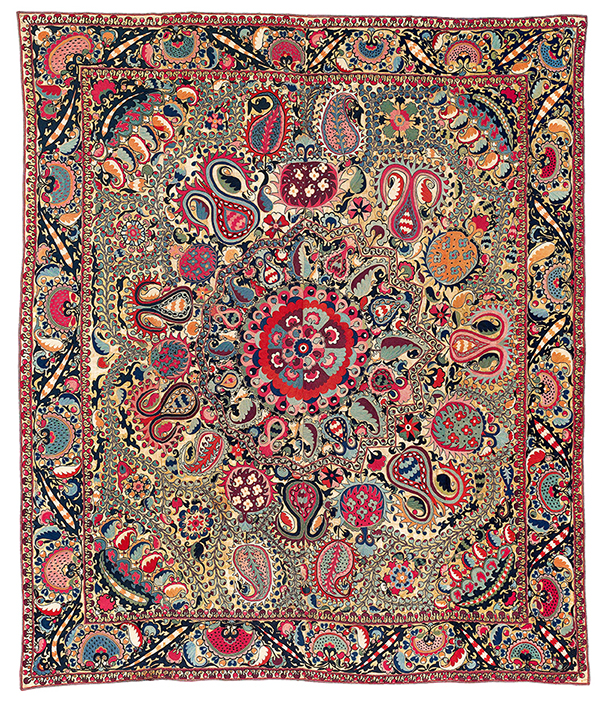For the Record. Rippon Boswell’s Lakai suzani
A world record price at auction for a Central Asian Lakai suzani of any description was paid for on 25 May 2013 for the catalogue cover piece in Rippon Boswell’s spring sale, lot 197, a large, densely intricate, blazingly colourful mandala-like ‘Lakai’ silk on silk embroidery from an old German collection which soared over its €29,000 estimate to a hammer price of €115,000 (€140,300 – almost $181,000 with 22% commission). It was bought by an anonymous telephone bidder against a London-based ‘agent’ bidding in the room, reportedly on behalf of a collector from the Southwestern USA, who pulled out at €110,000. Read more below

LAKAI-SHAHRISYABZ Suzani, Uzbekistan, First half 19th century. 255 x 216cm (8’41/2″ x 7’1″) Rippon Boswell, Wiesbaden 25 May 2013, lot 197, Est: €29,000,
Sold for: €143,000
The instant reaction to this powerful suzani was; ‘What the HECK were these guys ON?’ “Poppy juice, stupid” came the swift reply. The Lakai’s ill repute was fostered by Alexander Burnes’s account, from hearsay: “a tribe of Uzbeks, called Lakay [sic], who are celebrated for their plundering propensities” (Travels into Bokhara, London, 1834, vol. I, p.255) He noted that the female of the species shared the job description of the male – so not much time for sewing. Andy Hale and Kate Fitz Gibbon defend the Lakai, calling them conservative bandits’ (HALI 75, pp.68-79, note 1).
The ‘Bad Bey’ image of the Lakai does not chime with the sophistication of their suzani, which suggests the use of professionals, at least for the best pieces. Burnes says that they lived near Hissar (op.cit. p.255), to the east of Shahrisyabz. Many Shahrisyabz suzani share motifs with those associated with the Lakai, and both are sometimes attributed to Shkhrisyabz. Which all takes us back to the minefield of suzani attribution.
Initially, most Lakai suzani look bizarre, some to the point of dementia. But, as here, the best are meticulously synchronised, with exquisite drawing and terrific panache. The product of an ordered mind and an experienced hand, not some drug crazed brigand.
Worked on a ground of yellow silk, now worn away in places (they often are), this extraordinary suzani is filled with a multitude of ornament. With one motif inside another and within another, it is complex but not cluttered. The lines of stitching create a subtle shading, like brushstrokes.
Details, including a central mandala within a star medallion, recall a suzani attributed to Shahrisyabz, shown at the 2009 Berlin Volkmanntreffen (Gisela Helmecke: Gossmedallion-Suzani; Stickereien aus Mittelasien, Berlin, n.d., p.42, no.13). A yellow silk-ground example, in the Yanai Collection, has the same centre, and similar corner motifs and main border (Yigal Yanai: Suzani, Central Asian Embroideries, Tel Aviv, 1986, fig.15). Putting his piece in the second half of the 18th century, Yanai acknowledges a debt to Kashmiri shawl patterns. All three share a trailing pattern, like stems of currants (or grapes?). Neat bud and trefoil border guards appear on all four, and on others from the region. The flower-filled pomegranates find a less formal parallel in the field of a Vok Collection piece with a Shahrisyabz label (Suzani 2, no.72).
The large botehs with crisply turned tips echo a set of shawl designs brought home by William Moorcroft, in 1823. This gives us a date ante quem for this stage in the development of the boteh (John Irwin: The Kashmir Shawl, London, 1973, text plates 6- 3 – as opposed to the plates in the catalogue section, which are numbered separately). The lily-like shapes with two curled ‘petals’ are similar to a Kashmiri motif of two back to back boteh fused into a single motif with two ‘horns’. It occurs on a shawl in the V&A, dated to circa 1820, giving us another dating clue (Irwin, op. cit [catalogue] pl. 24; Frank Ames: The Kashmir Shawl, Woodbridge, 1988, p.307, pl. 210). Assuming that a specific design precedes its abstraction, we can thus deduce that the finest suzani with these distinctive motifs must be circa or post the 1820s.
A silk ground Lakai was shown at the 1996 Philadelphia ICOC (Oriental Rugs from Atlantic Collections, p.157, no.174). Though not a patch on this RB suzani, it was apparently given to the Russian royal family by an Emir of Bukhara. If it was thought fit for the Tsar of all the Russias, who on earth was this one for, God Almighty? The Khans of Transoxiana had no concept of the power of foreign rulers, nor of the opulence of their courts, believing these monarchs to live as they did (in mud-brick citadels in the back of beyond). So maybe it was to impress someone nearer home, or it was ordered by a rich Lakai Daddy for the wedding of his darling child.











